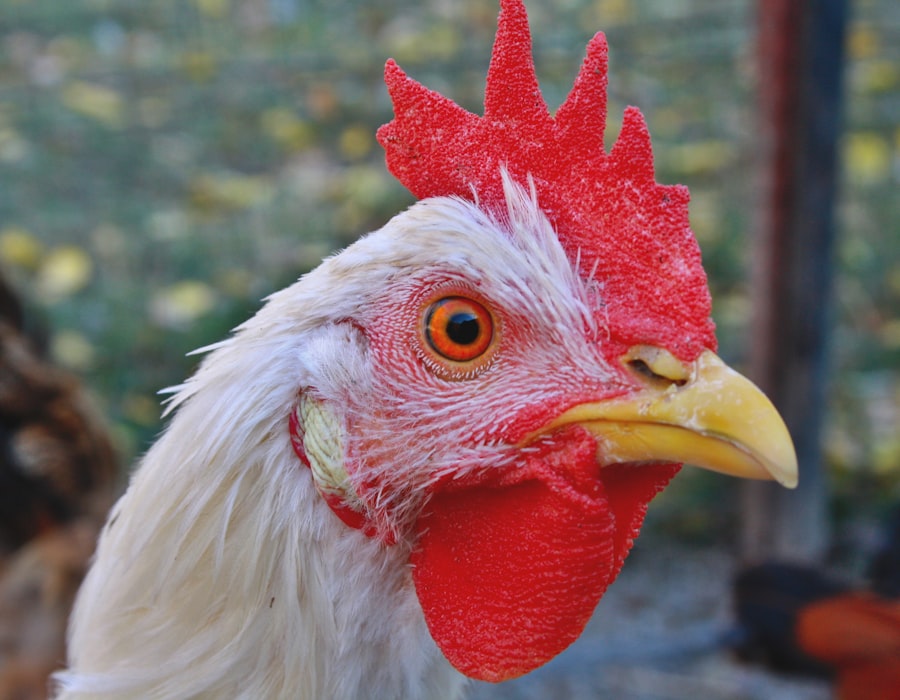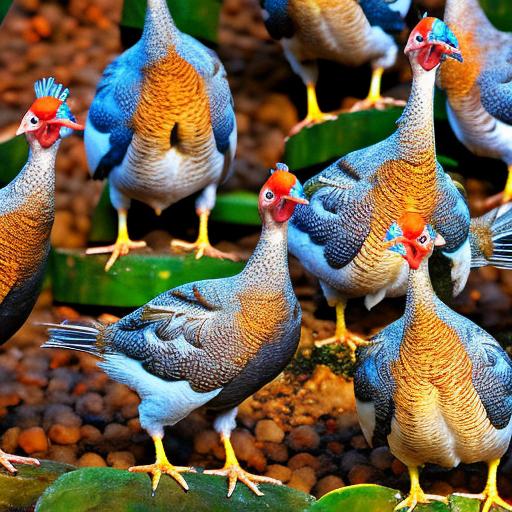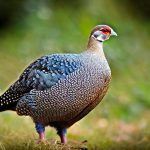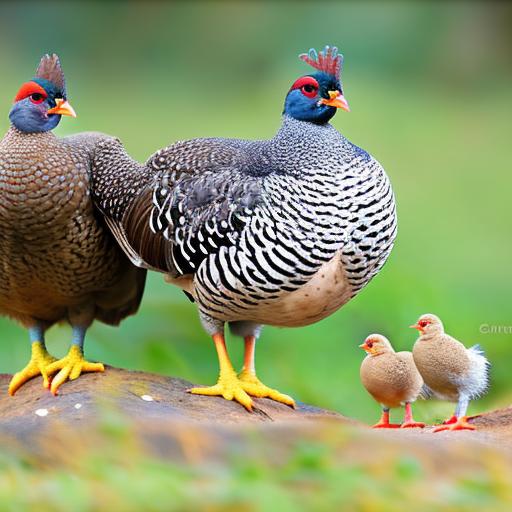Guinea fowl, also known as pintade, are a type of game bird native to Africa. They are closely related to domesticated chickens and are often raised for their meat, eggs, and pest control abilities. Guinea fowl are known for their distinctive appearance, with speckled feathers and a helmet-like crest on their heads. They are also known for their loud, distinctive calls that can be heard from a distance. Guinea fowl are hardy birds that can adapt to a variety of climates and are relatively low-maintenance compared to other poultry species. They are also known for their ability to forage for insects and other pests, making them a popular choice for organic pest control on farms and homesteads.
Guinea fowl meat is lean and flavorful, with a taste that is often compared to pheasant or wild game. The meat is darker and richer than chicken, and is prized for its unique flavor and texture. Guinea fowl meat is also high in protein and low in fat, making it a healthy choice for meat lovers. In addition to their meat, guinea fowl are also valued for their eggs, which are smaller and richer than chicken eggs. Guinea fowl eggs are often used in baking and cooking, and are considered a delicacy in many parts of the world. Overall, guinea fowl are a versatile and valuable addition to any farm or homestead, providing both meat and pest control benefits.
Key Takeaways
- Guinea fowl are a popular poultry choice for meat production due to their lean and flavorful meat, as well as their ability to forage for insects and pests.
- When selecting and raising guinea fowl for meat, it’s important to choose healthy birds from reputable sources and provide them with proper housing, feeding, and care to ensure optimal growth and development.
- Housing for guinea fowl should include a secure coop or shelter to protect them from predators, as well as access to a balanced diet of commercial feed, fresh water, and opportunities for foraging.
- Health and disease management for guinea fowl involves regular monitoring for signs of illness, providing vaccinations and preventive treatments, and maintaining a clean and sanitary environment to minimize the risk of disease.
- Processing and butchering guinea fowl for meat should be done humanely and hygienically, following proper techniques for slaughtering, plucking, and preparing the meat for consumption.
Selecting and Raising Guinea Fowl for Meat
When selecting guinea fowl for meat production, it is important to choose healthy, high-quality birds from a reputable breeder or hatchery. Look for birds that are active, alert, and free from any signs of illness or injury. Guinea fowl come in a variety of colors, including pearl, lavender, and royal purple, so choose the color that appeals to you the most. It is also important to consider the size of the birds, as larger birds will yield more meat. Once you have selected your guinea fowl, it is important to provide them with a suitable living environment. Guinea fowl are social birds and should be kept in groups of at least six to eight birds to prevent stress and aggression.
Raising guinea fowl for meat requires providing them with a balanced diet and access to fresh water at all times. Guinea fowl are omnivores and will eat a variety of foods, including grains, seeds, insects, and small rodents. A commercial game bird feed can be used as the primary source of nutrition for guinea fowl, supplemented with fresh fruits and vegetables. It is also important to provide guinea fowl with access to a large outdoor area where they can forage for insects and other natural foods. This will not only improve the flavor of the meat but also provide the birds with exercise and mental stimulation. Overall, raising guinea fowl for meat requires attention to their dietary needs and living conditions to ensure they grow healthy and produce high-quality meat.
Housing and Feeding Guinea Fowl
Guinea fowl require a suitable housing environment to thrive and produce high-quality meat. A well-ventilated coop or shelter is essential to protect the birds from predators and extreme weather conditions. The coop should be spacious enough to accommodate the number of birds you plan to raise, with at least 3-4 square feet of space per bird. It is important to provide roosting bars or platforms for the guinea fowl to perch on at night, as they prefer to sleep off the ground to avoid predators. The coop should also have nesting boxes for the hens to lay their eggs in a safe and comfortable environment.
In addition to a suitable living environment, guinea fowl require a balanced diet to ensure their health and productivity. A commercial game bird feed can be used as the primary source of nutrition for guinea fowl, as it is formulated to meet their specific dietary needs. The feed should be supplemented with fresh fruits and vegetables, as well as access to a large outdoor area where the birds can forage for insects and other natural foods. It is important to provide guinea fowl with access to fresh water at all times, as they can quickly become dehydrated in hot weather. Overall, providing guinea fowl with a suitable housing environment and balanced diet is essential for raising healthy birds and producing high-quality meat.
Health and Disease Management for Guinea Fowl
Maintaining the health of guinea fowl is essential for producing high-quality meat and ensuring the overall well-being of the birds. Regular health checks should be conducted to monitor the birds for any signs of illness or injury. Common health issues in guinea fowl include respiratory infections, parasites, and injuries from predators or aggressive behavior. It is important to provide guinea fowl with a clean living environment and access to fresh water at all times to prevent illness and dehydration. In addition, providing the birds with a balanced diet and access to natural foods will help support their immune system and overall health.
Disease management is an important aspect of raising guinea fowl for meat production. It is important to work with a veterinarian who has experience with poultry to develop a disease management plan for your flock. This may include vaccinations, regular health checks, and quarantine procedures for new birds. It is also important to practice good biosecurity measures to prevent the spread of disease within your flock. This includes keeping the coop clean and free from pests, as well as limiting contact with other poultry species. Overall, maintaining the health of guinea fowl requires regular monitoring, disease management planning, and good biosecurity practices to ensure the production of high-quality meat.
Processing and Butchering Guinea Fowl for Meat
Once guinea fowl have reached the desired weight for meat production, they can be processed and butchered for their meat. It is important to handle the birds humanely and minimize stress during the processing and butchering process. This can be achieved by using calm handling techniques and providing a quiet environment for the birds. The birds should be humanely slaughtered using a sharp knife or mechanical method to minimize pain and distress. Once slaughtered, the birds should be plucked or skinned to remove the feathers before gutting and cleaning the carcass.
After butchering, the guinea fowl meat can be stored in the refrigerator or freezer for future use. The meat can be used in a variety of recipes, including roasting, grilling, or braising. Guinea fowl meat has a rich flavor that pairs well with herbs and spices, making it a versatile choice for cooking. The meat can also be used in soups, stews, and casseroles for a hearty and flavorful meal. Overall, processing and butchering guinea fowl for meat production requires careful handling and attention to food safety practices to ensure the production of high-quality meat.
Cooking and Eating Guinea Fowl Meat

Guinea fowl meat is prized for its rich flavor and tender texture, making it a popular choice for cooking and eating. The meat can be prepared using a variety of cooking methods, including roasting, grilling, braising, or frying. When cooking guinea fowl meat, it is important to use gentle cooking methods to preserve its tenderness and flavor. The meat can be seasoned with herbs and spices such as thyme, rosemary, garlic, and lemon to enhance its natural flavor.
Guinea fowl meat can be used in a variety of recipes, including soups, stews, casseroles, and salads. The rich flavor of the meat pairs well with hearty vegetables such as potatoes, carrots, and onions, making it a versatile choice for cooking. The meat can also be used in international dishes such as Moroccan tagines or French coq au vin for a unique and flavorful meal. Overall, cooking and eating guinea fowl meat provides an opportunity to enjoy a delicious and nutritious protein source that is prized for its unique flavor and versatility in the kitchen.
Conclusion and Tips for Keeping Guinea Fowl for Meat
In conclusion, raising guinea fowl for meat production requires attention to their housing, feeding, health management, processing, cooking, and eating aspects. Selecting healthy birds from reputable breeders or hatcheries is essential for starting a successful guinea fowl flock. Providing suitable housing with access to fresh water and balanced nutrition will support the health and productivity of the birds. Disease management planning and good biosecurity practices are essential for maintaining the health of guinea fowl throughout their lives.
Processing and butchering guinea fowl humanely is important for producing high-quality meat that can be enjoyed in a variety of delicious recipes. Cooking guinea fowl meat provides an opportunity to savor its rich flavor and tender texture in a wide range of dishes from around the world. Overall, keeping guinea fowl for meat production offers an opportunity to enjoy a unique protein source that is prized for its flavor, versatility in the kitchen, and pest control benefits on farms and homesteads.
If you’re considering raising guinea fowl for meat, you may also be interested in learning about the best practices for building a chicken coop and nest box. A well-designed coop is essential for the health and safety of your poultry. Check out this informative article on chicken coop and nest box construction to ensure that your guinea fowl have a comfortable and secure living space.
FAQs
What is guinea fowl?
Guinea fowl are a type of poultry bird that are native to Africa. They are known for their distinctive spotted feathers and are often kept for their meat.
What are the benefits of keeping guinea fowl for meat?
Guinea fowl meat is lean and flavorful, with a taste that is often compared to chicken or pheasant. They are also known for being good foragers, which can help reduce feed costs.
What do guinea fowl eat?
Guinea fowl are omnivores and will eat a variety of foods including insects, seeds, and grains. They are also known to forage for their own food, which can help reduce the need for commercial feed.
How do you raise guinea fowl for meat?
Raising guinea fowl for meat involves providing them with a suitable living environment, feeding them a balanced diet, and ensuring they have access to clean water. They also need to be protected from predators and given proper veterinary care.
What are some common health issues for guinea fowl?
Common health issues for guinea fowl include respiratory infections, parasites, and injuries from predators. It’s important to monitor the health of the birds and seek veterinary care if needed.
How long does it take to raise guinea fowl for meat?
Guinea fowl typically take about 14-16 weeks to reach market weight, which is around 3-4 pounds. However, this can vary depending on the breed and the specific feeding and management practices used.
What are some popular guinea fowl breeds for meat production?
Popular guinea fowl breeds for meat production include the French Guinea, the White Guinea, and the Pearl Guinea. These breeds are known for their meat quality and growth rate.
Meet Walter, the feathered-friend fanatic of Florida! Nestled in the sunshine state, Walter struts through life with his feathered companions, clucking his way to happiness. With a coop that’s fancier than a five-star hotel, he’s the Don Juan of the chicken world. When he’s not teaching his hens to do the cha-cha, you’ll find him in a heated debate with his prized rooster, Sir Clucks-a-Lot. Walter’s poultry passion is no yolk; he’s the sunny-side-up guy you never knew you needed in your flock of friends!







